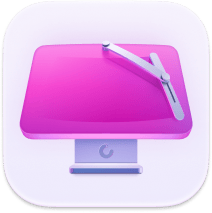How to free up RAM on Mac: 12 top tips to try
If you're plagued by the "Your system has run out of application memory" message, this means your Mac is using swap memory (disk space) to compensate, severely slowing performance. So, if your Mac is suddenly acting slow and sluggish, you might be wondering how to check the memory on your Mac. Luckily, we can do plenty to resolve this issue and get your Mac running smoothly again. So, let's jump in and look at how to reduce memory usage on your Mac.
What is RAM?
RAM (Random Access Memory) is essentially your Mac's short-term memory. It temporarily stores everything currently running in real time on your device. RAM storage is considered volatile memory — when there's no power or every time you restart your Mac, it gets cleared.
Signs of excessive RAM usage on Mac
When your Mac is using the majority of your available RAM, you might experience these issues:
-
Spinning beachball
-
Applications crashing
-
Low on memory message
-
Slow loading times
Read on to find out how to check and clear your Mac's memory.
How to check your memory usage on Mac
To check your RAM usage:
-
Open the Finder and go to Applications > Utilities > Activity Monitor.
-
Now, select the Memory tab.
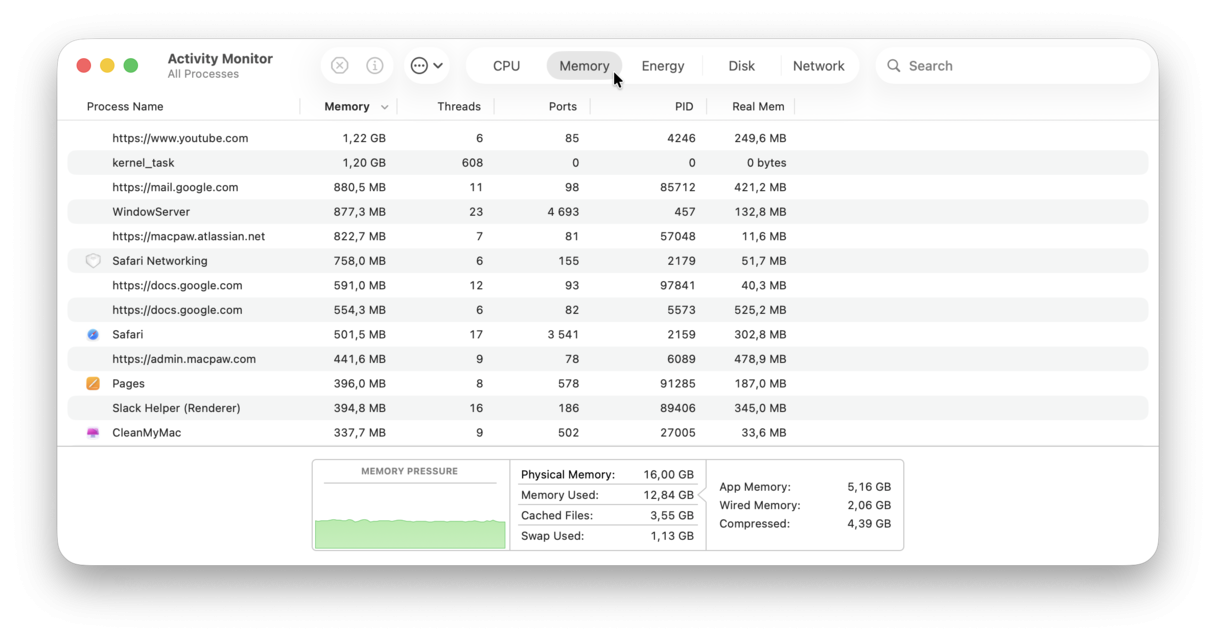
Activity Monitor shows all of your processes and how much memory each one is taking up.
At the bottom is a little graphical representation and totals, but what does this all mean?
- App memory: Memory being used by apps.
- Wired memory: Memory used by the system to operate.
- Compressed: Memory that has been compressed to make more RAM available.
- Cached files: Memory available for new tasks.
- Swap used: Memory used by macOS.
Check out the graph under memory pressure, too. It has a colored indication of how your Mac is doing:
- Green — everything is OK
- Yellow — constrained memory
- Red — critically low RAM, action needed
So, if the graph shows a lot of red and yellow, your Mac is struggling for free memory. But worry not, we'll show you how to clear memory on your Mac in the next section.
How to lower RAM usage on Mac
Knowing how to clean up memory on Mac is essential. Here are a few tips to keep your Mac optimized.
1. Flush RAM quickly
There are many ways to free up RAM, but if you want an instant solution, try this. CleanMyMac has a one-button RAM flusher. You can use it anytime, whenever your Mac has a memory overload.
- Get your free CleanMyMac trial.
- Once installed, click the small iMac icon in the upper menu bar.

In the Menu App that appears, find the Memory tab and click Free Up. That's it!

Why use CleanMyMac?
- 17+ years of cleaning, optimizing, and maintaining Macs — on the market since 2008
- Takes care of more than 50K Macs daily
- Rated 4.7/5 on Trustpilot
- Used in 180+ countries
- Winner of the Red Dot Award and the iF Design Award
2. Restart your Mac
Sounds obvious, but since RAM is temporary memory, when your Mac restarts, it will empty the RAM and any disk caches, so this is actually a pretty quick and easy way of cleaning up memory.
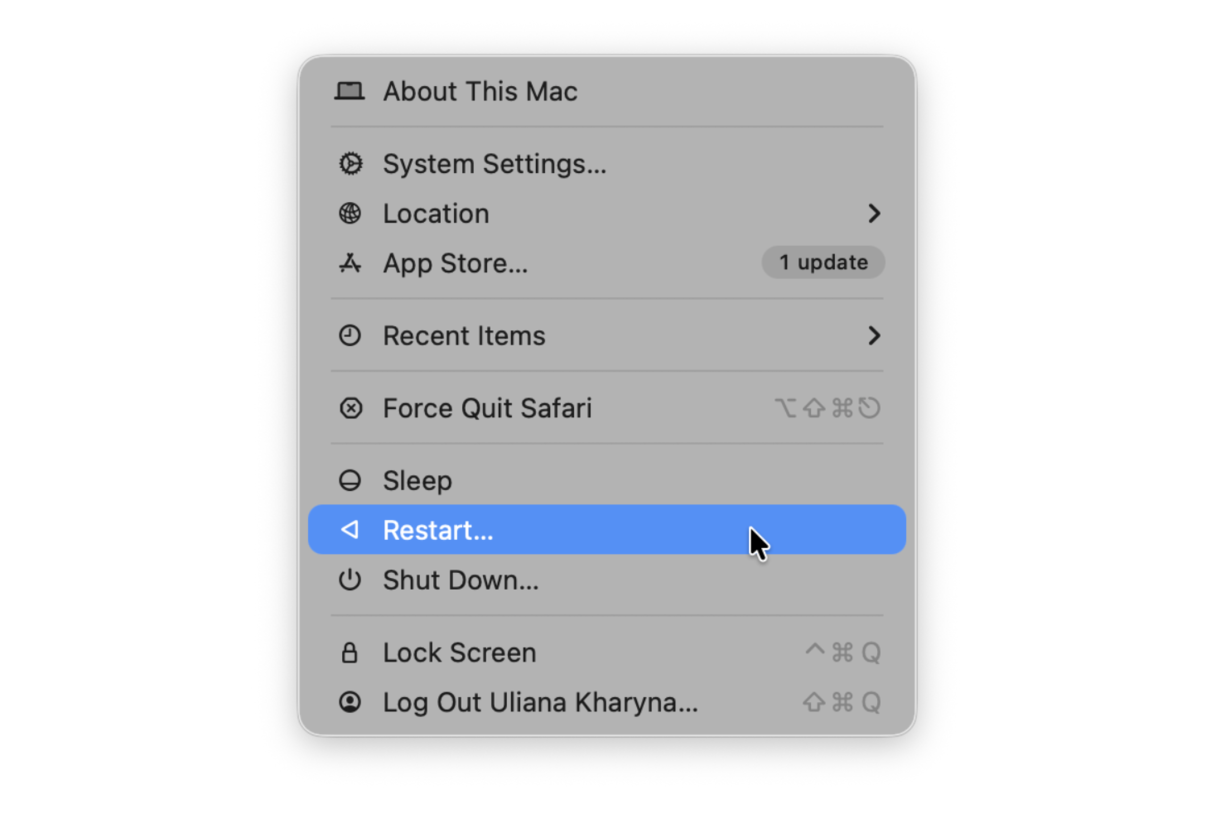
3. Check Activity Monitor
Check Activity Monitor and quit applications that are using a lot of RAM. Here's how:
-
Open the Finder, then Applications > Utilities > Activity Monitor > Memory.
-
From the list, select any process or app that is hogging memory and click the "X" to quit it.
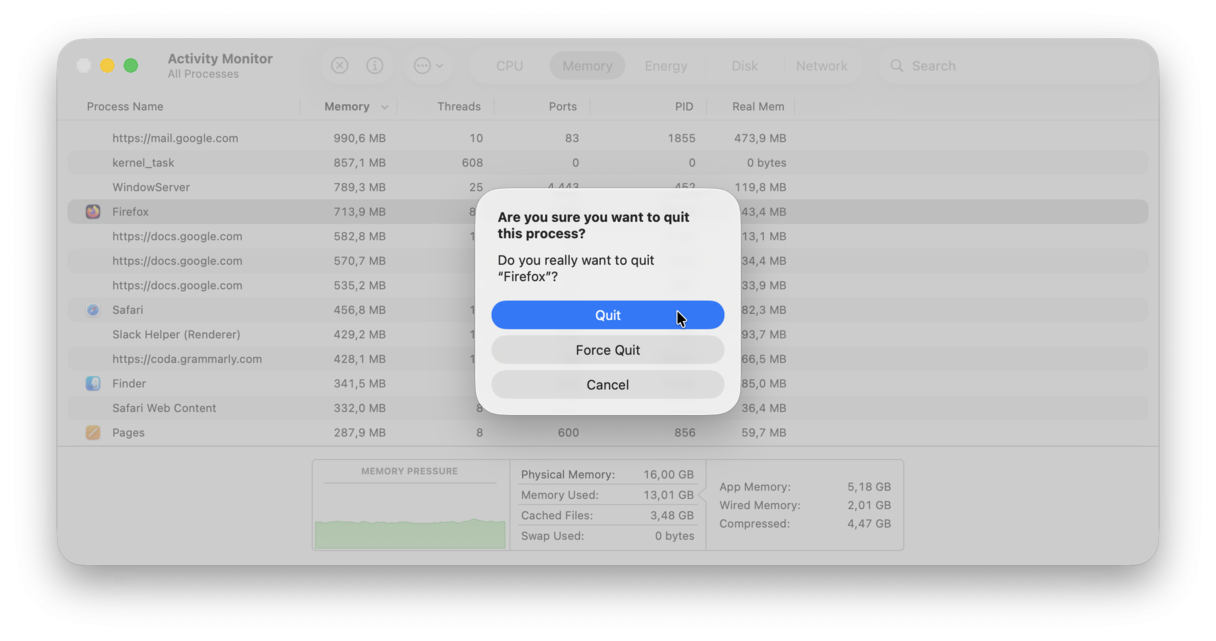
Look for common memory hogs like Photoshop, Google Chrome, VMs, etc. Note that quitting processes is not always safe, so instead, quit apps hogging memory.
Important: If high memory usage returns immediately after you quit an app, it suggests a memory leak. Try reinstalling the app. If you cannot do it, follow the steps below one by one.
4. Tidy your desktop
The more icons you have lying around on your desktop, the more memory is used. Take a look at what's sitting on your desktop right now and have a tidy-up.
We love using stacks to keep desktop in order. The Stacks feature categorizes items and puts them together in neat little piles. Right-click anywhere on your desktop and choose Use Stacks from the menu.
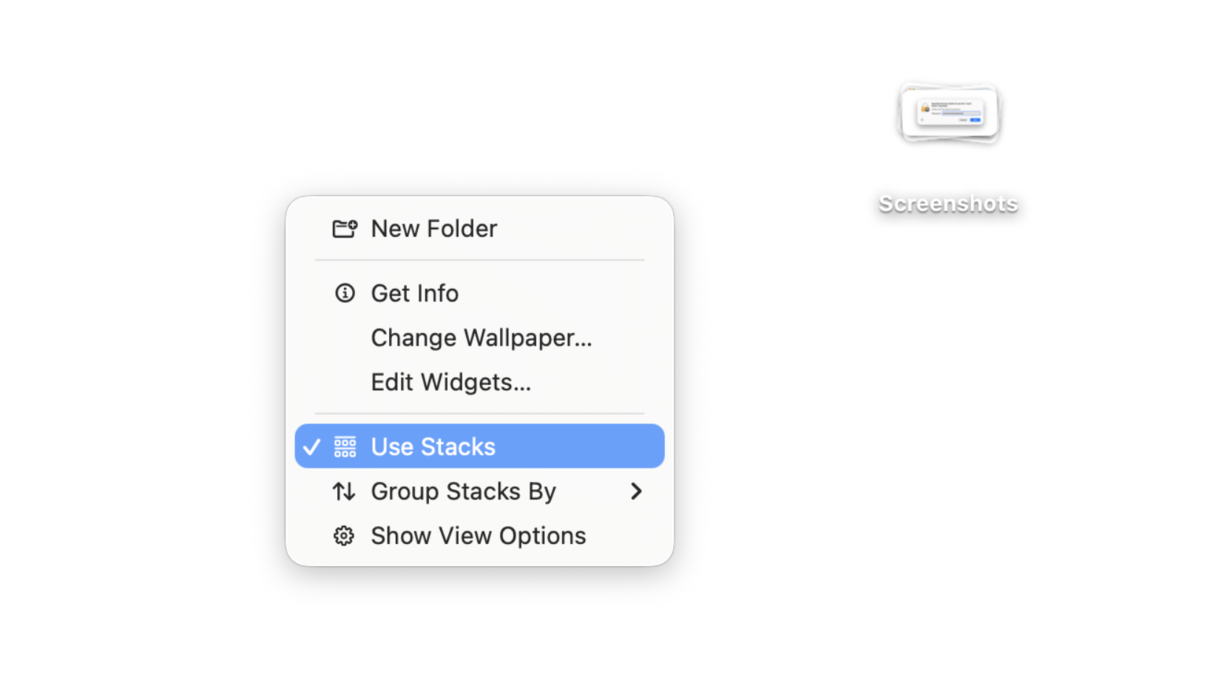
5. Clear up system junk
To optimize the available RAM you do have, it's a good idea to clean up your system junk, like temporary files, cache, incomplete downloads, or old logs. You can spend hours trawling through folders or you can use a dedicated tool like CleanMyMac to do all the hard work for you with just a few clicks. Bonus points for this app being notarized by Apple.
Here's how to clean your system junk with CleanMyMac:
-
Go to Cleanup from the left sidebar.
-
Click Scan and then Clean.

6. Close Finder windows
In the Finder, you can use multiple tabs to access different folders instantly. Convenient as it is, it also consumes memory in the background, so closing unnecessary Finder windows is a good idea.
Here's how:
- Go to the Finder.
- Hover the mouse pointer over the tab you want to close and click x.
- Repeat for all unneeded windows.
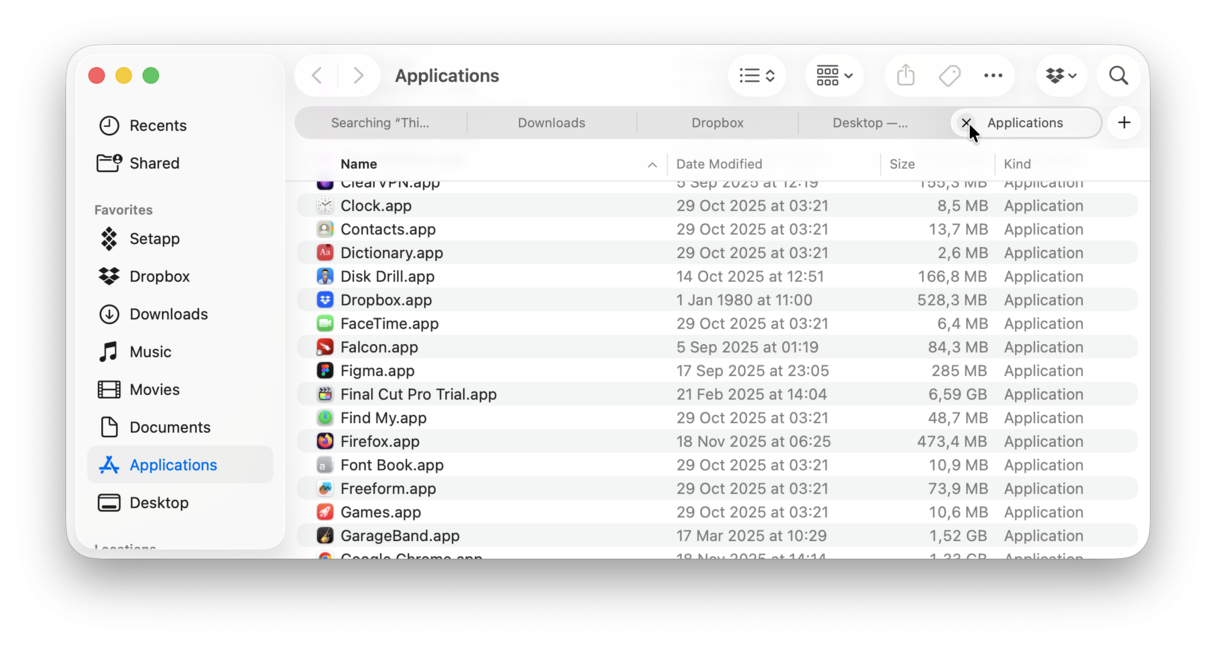
7. Close browser tabs
Another memory eater is browser tabs. Just like with the Finder windows, they sit silently and hog your Mac's resources. If you use several browsers at a time and have multiple tabs open in each of them, it may significantly slow down your Mac. So, go to your browser and close unnecessary tabs by clicking x next to the tab's name.
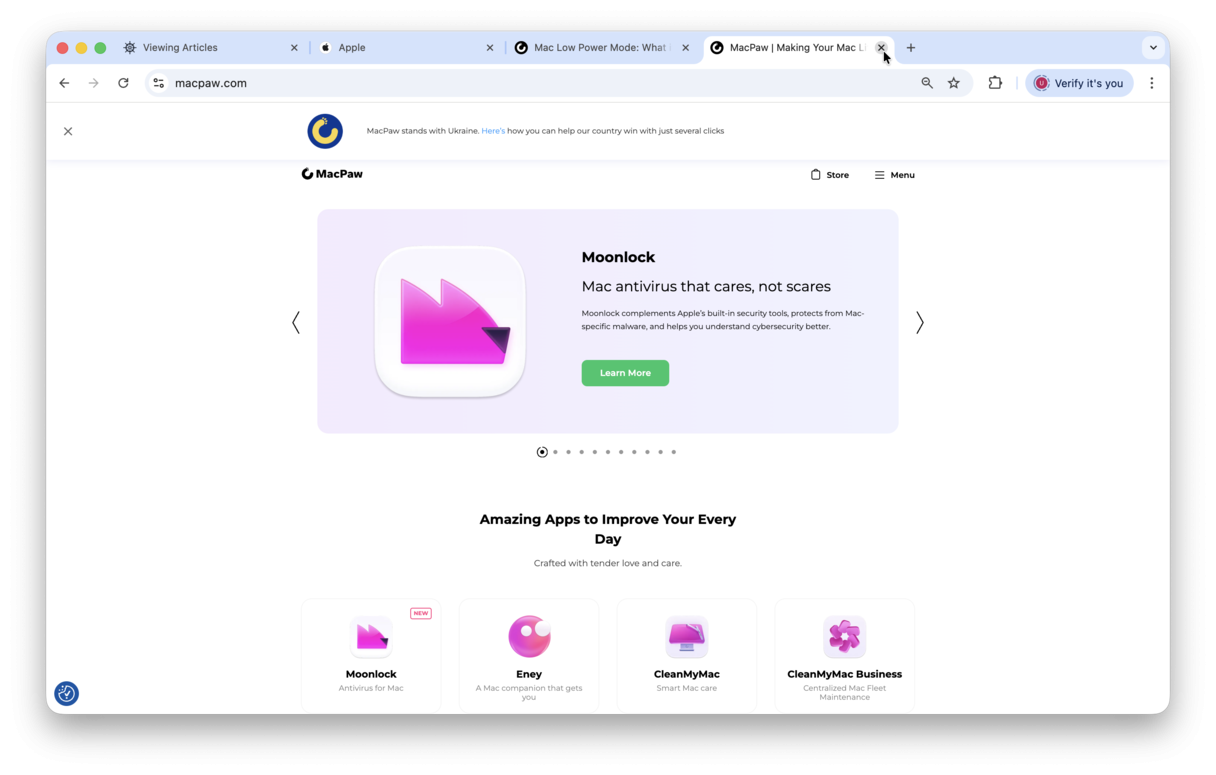
If you think you might need any of them in the future, just bookmark them — check out this handy guide on everything you need to know about bookmarks.
8. Remove browser extensions
One more quick tip is to remove browser extensions you are not using. Keep only the most needed ones. The steps for deleting extensions vary for different browsers:
- Safari. Open Safari Settings and go to Extensions. Select the unneeded one and click Uninstall. Repeat for all extensions you want to remove.
- Chrome. Paste chrome://extensions/ into the address bar and click Remove under unnecessary extensions.
- Firefox. Paste about:addons into the address bar and click the ellipsis next to an extension. Choose Remove and confirm the removal.
For Chrome and Firefox, you can try disabling unneeded extensions first and check if it helps lower RAM. To do it, use the toggle next to the extension's name and slide it to the off position.
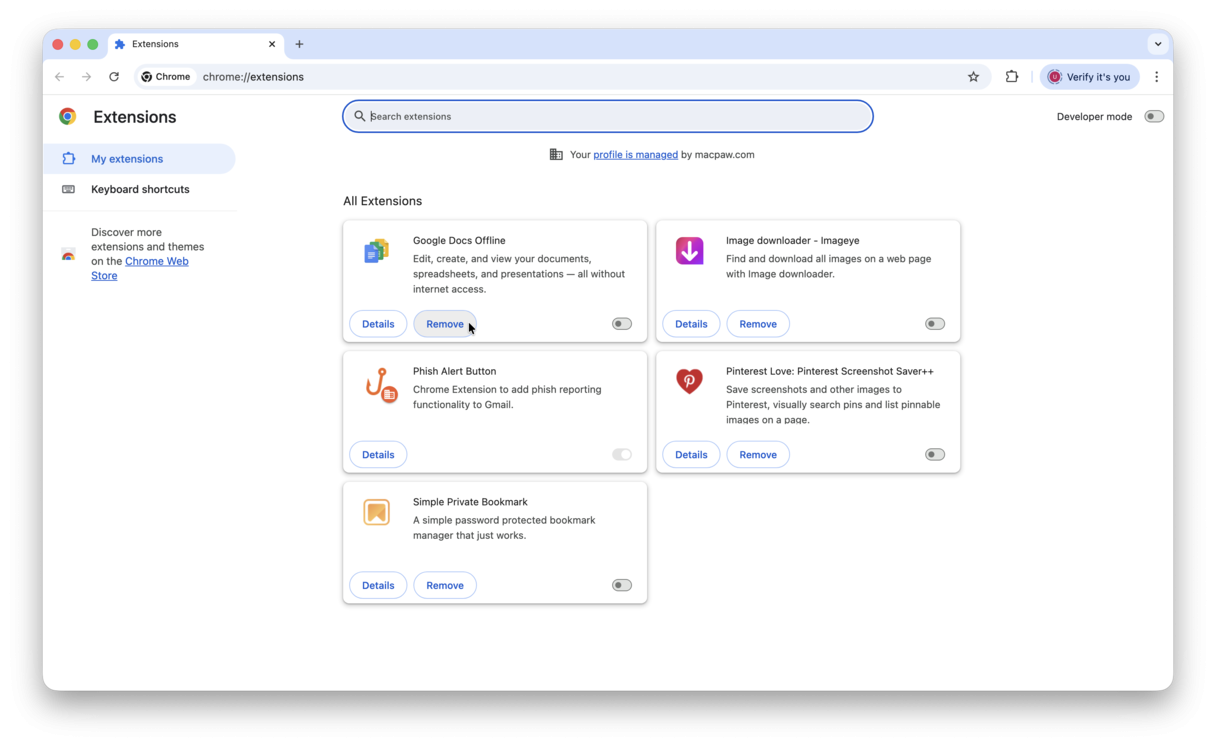
9. Disable login items
Login items are another common source of memory usage. Unknowingly, we can often have several installed that we rarely use, but they hog memory. Here's how to check and remove:
-
Go to Apple menu > System Settings > General > Login Items & Extensions.
-
Remove any applications you no longer want to launch when your Mac starts: select them in the list and click the "-" button.
- Look through the background apps and disable those you don't need running.

Tip: While in System Settings > General, check the Storage tab. Not having enough space is another reason why your Mac is slow. If you see that you're running out of space, check out this article on how to free up disk space.
10. Update your macOS
Sometimes, your Mac may use too much RAM because it is running an older macOS version. The thing is that each new macOS comes with not only new features but also performance improvements, so it may be better optimized. Therefore, make sure to update your macOS to the latest version compatible with your Mac. Here's how to do it:
- From the main Apple menu, go to System Settings > General > Software.
- Click Update Now or Restart Now if an update is available. Enabling Automatic updates is also a good idea.

11. Check CPU usage
You can also quit CPU-intensive apps to free up some more RAM. Here's how:
- Once again, open Activity Monitor from Applications > Utilities.
- This time, click CPU and quit apps at the top of the list if you don't use them.
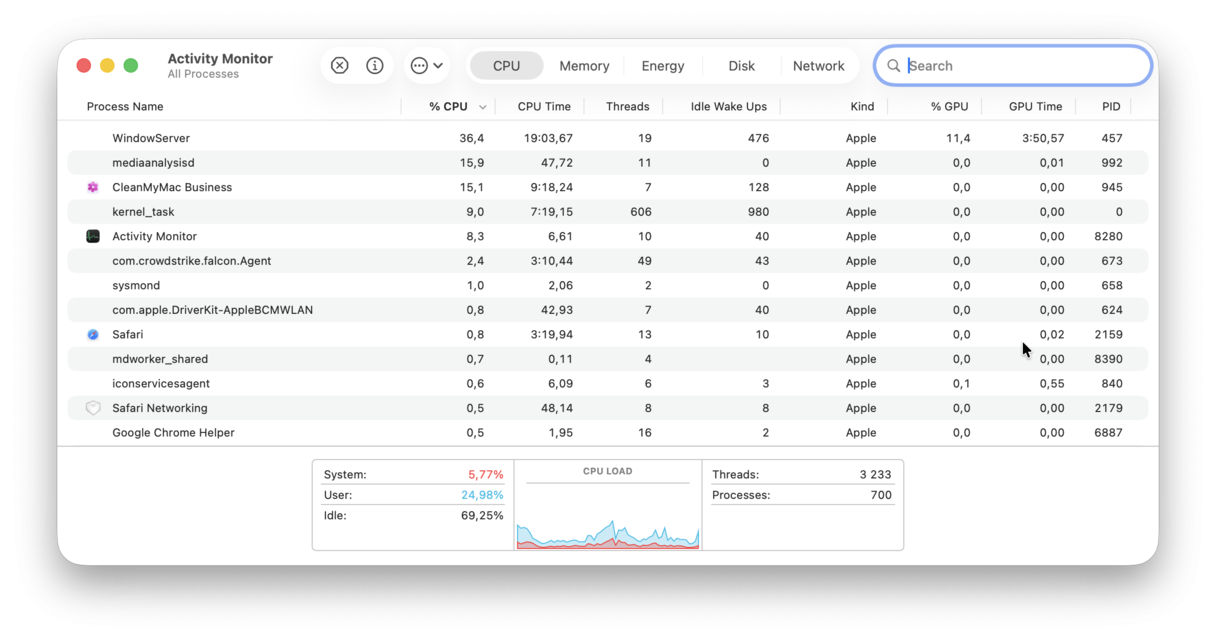
12. Purge RAM in Terminal
Finally, you can use Terminal to purge RAM. Terminal is a command line interface that allows you to communicate with your Mac's operating system by entering commands. Note, though, that it may be associated with some risks:
- It may interfere with the macOS' normal operation if you decide to flush RAM manually.
- You may lose some unsaved data and temporary files.
- You may invoke other commands accidentally, which might lead to different issues — from file corruption and data loss to system glitches.
- It may temporarily freeze your Mac — for like 10 to 30 seconds.
If you decide that you want to use Terminal, follow the steps below precisely:
- Open Terminal from Applications > Utilities.
- Enter this command followed by Return:
sudo purge
- Type your admin password and press Return.
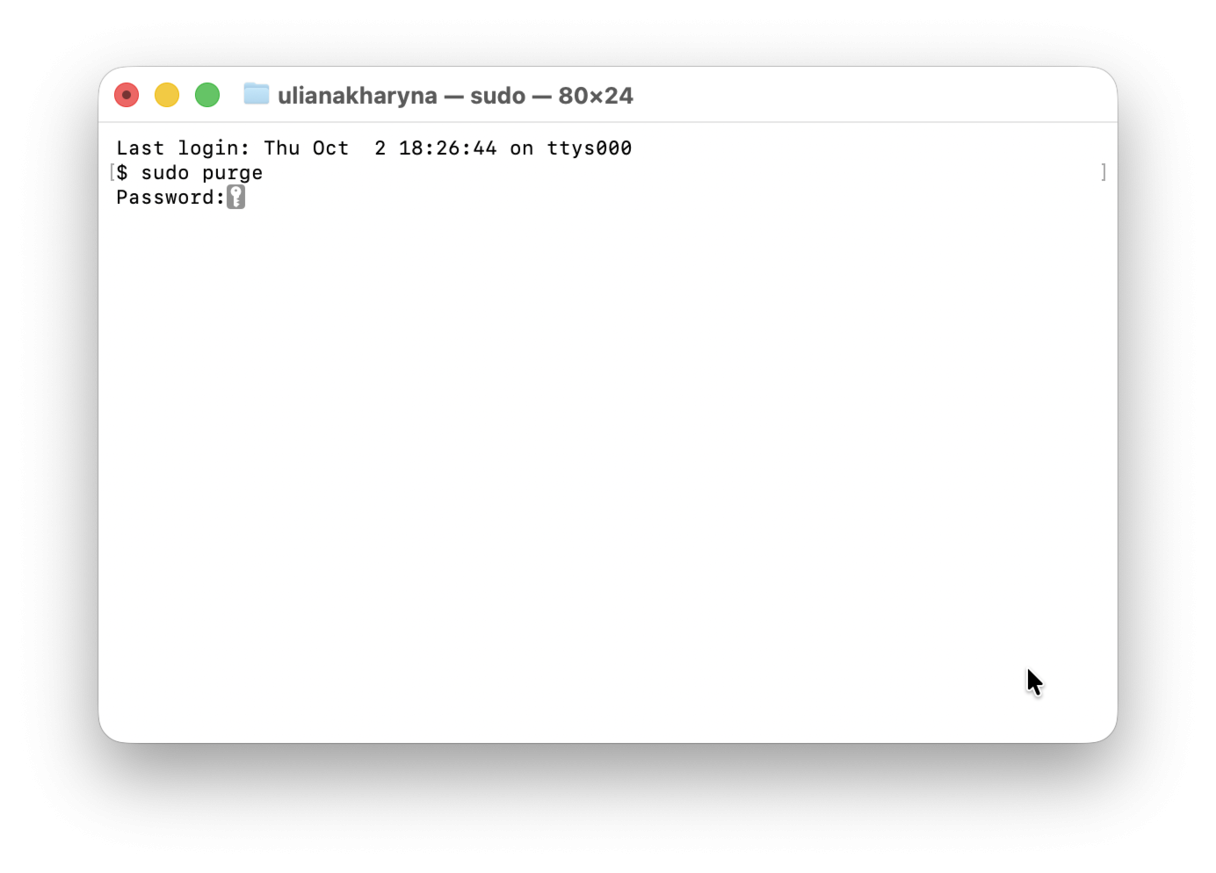
How much RAM does your Mac need
You need to answer this question before purchasing a new Mac. It is because new MacBooks do not come with upgradable RAM. So, think about what you plan to use your Mac for and choose wisely:
📌 16 GB (minimum for new Macs) — basic usage like browsing and working with texts, some photo editing
📌 32 GB — enough for intensive photo and video editing and gaming
📌 64 GB — recommended if you plan to use virtualization software or other similar tools frequently
If you still have an old Mac with lower memory capacity, there's no need to rush and buy a new computer. The only case in which you should seriously consider an upgrade is when basic tasks cause red memory pressure all the time.
When to upgrade and when to optimize
If you have an older Mac, you can try upgrading your RAM. When? Consider doing it if the memory pressure is constantly red when you use fewer than 5 apps or have fewer than 10 browser tabs open at a time.
For an entire list of such MacBooks and instructions on how to remove or install memory, check out this article from Apple Support.
If your Mac is not on the list, unfortunately, you cannot add more memory. The only option for you is to optimize RAM usage by following the steps we've listed above from time to time.
How to prevent future RAM issues
Regardless of whether you can upgrade the RAM or just optimize it, there are a few things you can do to prevent RAM issues in the future. Here are a few best practices:
✅ Quit apps you do not need at the moment.
✅ Close all unnecessary browser tabs — add those you might need to return to later to the reading list or bookmark them.
✅ Avoid intensive apps if your Mac comes with the minimum RAM (8 or 16 GB). If you need to test them, quit all other intensive apps (including all browsers).
✅ Monitor RAM usage via Activity Monitor or ClanMyMac Menu App.
✅ Keep macOS and all the apps updated — new versions are usually better optimized.
✅ Restart your Mac every now and then.
There we are. Now you know how to check the memory on your Mac and how to clear it manually or using a Mac memory cleaner. See you back here soon for more great tips.
Frequently asked questions
What to do if RAM usage is 100%?
As long as the graph under memory pressure is green, you have nothing to worry about. It is a normal behavior since macOS caches a lot of stuff every moment. Take action only if the graph turns yellow or red.
Is it safe to purge RAM via Terminal?
Yes, but it is not always necessary for modern Macs since they manage memory more efficiently. Also, note that it is ineffective for long-term memory optimization; if you have to do it daily (which is not recommended), take other steps and consider an upgrade.
Can I upgrade RAM on Macs with Apple silicon (like M1 or other M-series)?
No, since memory is soldered into the motherboard, you cannot upgrade it. Of course, you can look for professional assistance and try to replace the motherboard, but it is too expensive and makes little to no sense.
How often should I restart my Mac?
There's no right or wrong answer, but we suggest doing it weekly for Mac maintenance.

